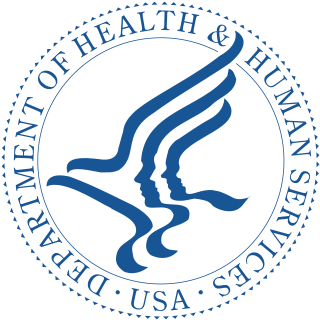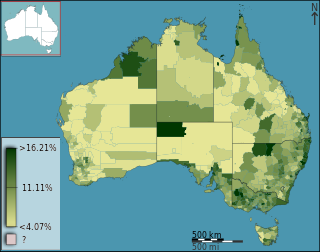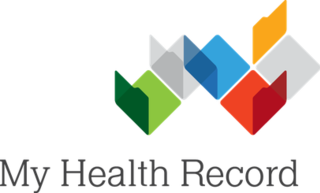
The United States Department of Health and Human Services (HHS) is a cabinet-level executive branch department of the U.S. federal government created to protect the health of the U.S. people and providing essential human services. Its motto is "Improving the health, safety, and well-being of America". Before the separate federal Department of Education was created in 1979, it was called the Department of Health, Education, and Welfare (HEW).
Medicare is the publicly funded universal health care insurance scheme in Australia operated by the nation's social security agency, Services Australia. The scheme either partially or fully covers the cost of most health care, with services being delivered by state and territory governments or private enterprises. All Australian citizens and permanent residents are eligible to enrol in Medicare, as well as international visitors from 11 countries that have reciprocal agreements for medically necessary treatment.

The minister of health is the minister of the Crown in the Canadian Cabinet who is responsible for overseeing health-focused government agencies including Health Canada and the Public Health Agency of Canada, as well as enforcing the Canada Health Act, the law governing Canada's universal health care system.
Medical privacy, or health privacy, is the practice of maintaining the security and confidentiality of patient records. It involves both the conversational discretion of health care providers and the security of medical records. The terms can also refer to the physical privacy of patients from other patients and providers while in a medical facility, and to modesty in medical settings. Modern concerns include the degree of disclosure to insurance companies, employers, and other third parties. The advent of electronic medical records (EMR) and patient care management systems (PCMS) have raised new concerns about privacy, balanced with efforts to reduce duplication of services and medical errors.

The Health Insurance Portability and Accountability Act of 1996 is a United States Act of Congress enacted by the 104th United States Congress and signed into law by President Bill Clinton on August 21, 1996. It aimed to alter the transfer of healthcare information, stipulated the guidelines by which personally identifiable information maintained by the healthcare and healthcare insurance industries should be protected from fraud and theft, and addressed some limitations on healthcare insurance coverage. It generally prohibits healthcare providers and businesses called covered entities from disclosing protected information to anyone other than a patient and the patient's authorized representatives without their consent. The bill does not restrict patients from receiving information about themselves. Furthermore, it does not prohibit patients from voluntarily sharing their health information however they choose, nor does it require confidentiality where a patient discloses medical information to family members, friends or other individuals not employees of a covered entity.
The Pharmaceutical Benefits Scheme (PBS) is a program of the Australian Government that subsidises prescription medication for Australian citizens and permanent residents, as well as international visitors covered by a reciprocal health care agreement. The PBS is separate to the Medicare Benefits Schedule, a list of health care services that can be claimed under Medicare, Australia's universal health care insurance scheme.

A Medicare card is a plastic card, the same size as a typical credit card, issued to Australian citizens and permanent residents and their families. The card or the Medicare number is required to be provided to enable the cardholder to receive a rebate of medical expenses under Australia's Medicare system, as well as subsidised medications under the Pharmaceutical Benefits Scheme (PBS). The card is usually green in colour, although interim cards are light blue and cards for Reciprocal Health Care Agreement visitors are light yellow. The cards are issued by a government agency called Services Australia.
The Royal Commission on the Future of Health Care in Canada, also known as the Romanow Report, is a committee study led by Roy Romanow on the future of health care in Canada. It was delivered in November 2002.
The NHS Electronic Prescription Service is part of the NHS National Programme for IT of the National Health Service in England. It enables the electronic transfer of medical prescriptions from doctors to pharmacies and other dispensers and electronic notification to the reimbursement agency, NHS Prescription Services.
Services Australia, formerly the Department of Human Services and before that the Department of Social Security, is an executive agency of the Australian Government, responsible for delivering a range of welfare payments, health insurance payments, child support payments and other support services to eligible Australian citizens and permanent residents. Services Australia delivers social services through the government programs Centrelink, Medicare, the PBS and the Child Support Agency. Eligible Australian citizens and permanent residents can access many of these services through a myGov account.
The National Council for Prescription Drug Programs (NCPDP) is an American nonprofit standards development organization representing most sectors of the U.S. pharmacy services industry. It was founded in 1977 as the extension of a Drug Ad Hoc Committee that made recommendations for the U.S. National Drug Code (NDC). It is based in Scottsdale, Arizona.
CVS Health Corporation is an American healthcare company that owns CVS Pharmacy, a retail pharmacy chain; CVS Caremark, a pharmacy benefits manager; and Aetna, a health insurance provider, among many other brands. The company is the world's second largest healthcare company, behind UnitedHealth Group. In 2023, the company was ranked 64th in the Forbes Global 2000.

Mathias Hubert Paul Cormann is a Belgian-born Australian politician and diplomat who currently serves as Secretary-General of the Organisation for Economic Co-operation and Development (OECD), having assumed the office on 1 June 2021.

Health care in Australia operates under a shared public-private model underpinned by the Medicare system, the national single-payer funding model. State and territory governments operate public health facilities where eligible patients receive care free of charge. Primary health services, such as GP clinics, are privately owned in most situations, but attract Medicare rebates. Australian citizens, permanent residents, and some visitors and visa holders are eligible for health services under the Medicare system. Individuals are encouraged through tax surcharges to purchase health insurance to cover services offered in the private sector, and further fund health care.
Electronic prescription is the computer-based electronic generation, transmission, and filling of a medical prescription, taking the place of paper and faxed prescriptions. E-prescribing allows a physician, physician assistant, pharmacist, or nurse practitioner to use digital prescription software to electronically transmit a new prescription or renewal authorization to a community or mail-order pharmacy. It outlines the ability to send error-free, accurate, and understandable prescriptions electronically from the healthcare provider to the pharmacy. E-prescribing is meant to reduce the risks associated with traditional prescription script writing. It is also one of the major reasons for the push for electronic medical records. By sharing medical prescription information, e-prescribing seeks to connect the patient's team of healthcare providers to facilitate knowledgeable decision making.
Electronic Prescriptions for Controlled Substances (EPCS) was originally a proposal for the DEA to revise its regulations to provide practitioners with the option of writing electronic prescriptions for controlled substances. These regulations would also permit pharmacies to receive, dispense, and archive these electronic prescriptions. These proposed regulations would be an addition to, not a replacement of, the existing rule.
The Health Information Technology for Economic and Clinical Health Act, abbreviated the HITECH Act, was enacted under Title XIII of the American Recovery and Reinvestment Act of 2009. Under the HITECH Act, the United States Department of Health and Human Services resolved to spend $25.9 billion to promote and expand the adoption of health information technology. The Washington Post reported the inclusion of "as much as $36.5 billion in spending to create a nationwide network of electronic health records." At the time it was enacted, it was considered "the most important piece of health care legislation to be passed in the last 20 to 30 years" and the "foundation for health care reform."
The National Electronic Health Transition Authority (NEHTA) was established in July 2005 as a joint enterprise between the Australian Government and state and territory governments to identify, and develop the necessary foundations for electronic health (eHealth).
The 340B Drug Pricing Program is a US federal government program created in 1992 that requires drug manufacturers to provide outpatient drugs to eligible health care organizations and covered entities at significantly reduced prices. The intent of the program is to allow covered entities to "stretch scarce federal resources as far as possible, reaching more eligible patients and providing more comprehensive services." Maintaining services and lowering medication costs for patients is consistent with the purpose of the program, which is named for the section authorizing it in the Public Health Service Act (PHSA) It was enacted by Congress as part of a larger bill signed into law by President George H. W. Bush.

My Health Record (MHR) is the national digital health record platform for Australia, and is managed by the Australian Digital Health Agency. It was originally established as the Personally Controlled Electronic Health Record (PCEHR), a shared electronic health summary set up by the Australian government with implementation overseen by the National Electronic Health Transition Authority (NEHTA). The purpose of the MHR is to provide a secure electronic summary of people's medical history which will eventually include information such as current medications, adverse drug reactions, allergies and immunisation history in an easily accessible format. This MHR is stored in a network of connected systems with the ability to improve the sharing of information amongst health care providers to improve patient outcomes no matter where in Australia a patient presents for treatment. PCEHR was an opt-in system with a unique individual healthcare identifier (IHI) being assigned to participants and the option of masking and limiting information available for viewing controlled by the patient or a nominated representative; MHR uses an opt-out system.






